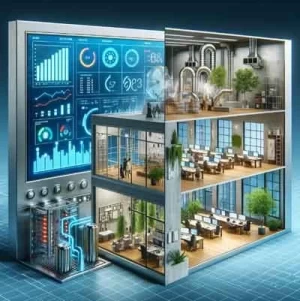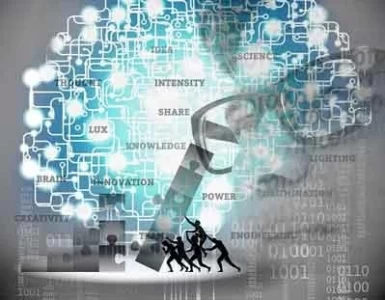Optimizing Energy Consumption with Demand Response

Building Automation Systems (BAS) play a crucial role in optimizing energy consumption within buildings. However, BAS can extend their reach beyond individual buildings and contribute to the stability and efficiency of the entire power grid. This is achieved through Demand Response (DR) programs, which incentivize building owners to adjust their energy consumption patterns based on real-time grid needs. This article explores how BAS can be utilized as a tool for DR participation, highlighting the benefits for building owners, utilities, and the overall energy landscape.
Visit Our Building Automation Study Course
The Challenge of Peak Demand: Why Demand Response Matters
The electricity grid faces a constant challenge – balancing electricity supply with demand. During peak demand periods, typically hot summer days or cold winter evenings, the demand for electricity can surge beyond what the grid can reliably supply. This can lead to brownouts, blackouts, and increased energy costs for consumers. Demand Response (DR) programs offer a solution by incentivizing building owners to reduce their energy consumption during peak periods. This reduction in demand helps alleviate pressure on the grid, promoting grid stability and potentially lowering overall energy costs.
The BAS Advantage: Enabling Building Participation in DR
BAS are ideally suited to facilitate building participation in DR programs. Here's how:
Real-Time Data Monitoring: BAS continuously collect real-time data on energy consumption within a building.
Communication Protocols: Modern BAS can communicate with utility providers through standardized communication protocols like OpenADR, enabling buildings to receive DR event signals.
Control Capabilities: BAS are equipped with control capabilities that allow them to adjust building systems in response to DR events. This may involve measures like raising or lowering HVAC setpoints, dimming lights, or temporarily switching off non-critical equipment.
Automated Response: BAS can be programmed to automatically trigger pre-defined DR strategies upon receiving DR event signals from utilities.
Integration with Other Systems: Advanced BAS can integrate with other building management systems like lighting controls or building management software, allowing for a more comprehensive approach to DR implementation.
Benefits of Building Participation in DR
Building owners can reap several benefits by participating in DR programs through BAS:
Financial Incentives: Utilities offer financial incentives to building owners in exchange for reducing energy consumption during DR events. These incentives can take the form of direct payments, rebates on electricity bills, or participation in energy markets.
Reduced Energy Costs: By participating in DR programs, building owners can identify areas of high energy consumption and implement long-term energy-saving strategies. This can lead to lower overall energy costs beyond just DR events.
Enhanced Grid Reliability: By contributing to grid stability through DR participation, building owners become part of the solution in ensuring a reliable and resilient power grid.
DR Programs: Options and Considerations
There are several types of DR programs with varying response times and required actions:
Direct Load Control: In this program, utilities directly control specific building systems, such as HVAC equipment, during DR events. Building owners typically receive automated communication from utilities through BAS to implement these controls.
Price-Based Programs: These programs reflect real-time energy prices. Building owners are incentivized to reduce energy consumption when electricity prices are high during peak demand periods. BAS can be programmed to automatically adjust building systems based on real-time price signals received from utilities.
Capacity Markets: Building owners can participate in capacity markets by offering the ability to reduce their energy consumption during peak periods in exchange for financial compensation. BAS can facilitate automated responses to capacity market events.
Technical Considerations for BAS Integration with DR
Implementing BAS for DR participation requires careful consideration of several technical aspects:
BAS Capabilities: Building owners need to ensure their BAS is equipped with the necessary communication protocols and control capabilities to participate in DR programs.
DR Program Compatibility: Different DR programs may have varying communication protocols and response requirements. BAS needs to be compatible with the specific DR program a building owner chooses to participate in.
DR Strategy Development: Building owners need to develop pre-defined DR strategies for BAS to implement during DR events. These strategies should balance energy reduction with occupant comfort and operational needs.
Occupant Communication: Building owners need to communicate DR participation and potential impacts on occupant comfort to building occupants well in advance to minimize disruption and ensure program effectiveness.
Beyond Buildings, a More Sustainable Grid
The integration of BAS with DR programs offers benefits that extend beyond individual buildings:
Grid Stability and Reliability: Widespread participation in DR programs by buildings equipped with BAS can significantly contribute to grid stability and reliability. By reducing peak demand, DR programs can help prevent blackouts and brownouts, ensuring a more resilient power grid.
Reduced Emissions and Environmental Benefits: Lower peak demand translates to reduced reliance on fossil fuel power plants during these periods. This can lead to lower greenhouse gas emissions and contribute to environmental goals.
Integration of Renewable Energy: DR programs can pave the way for greater integration of renewable energy sources into the grid. By flexibly adjusting demand, the grid can better accommodate the intermittent nature of renewable energy sources like solar and wind power.
Building a Collaborative Future
Demand Response (DR) programs offer a win-win situation for building owners, utilities, and the environment. Building Automation Systems (BAS) play a crucial role in facilitating building participation in DR programs by enabling real-time communication, automated control strategies, and seamless integration with utility systems. By embracing BAS technology and participating in DR programs, building owners can contribute to a more stable, efficient, and environmentally friendly power grid for the future. As technology continues to evolve and DR programs become more widespread, collaboration between building owners, utilities, and technology providers will be essential to maximize the benefits of this innovative approach to grid management.









